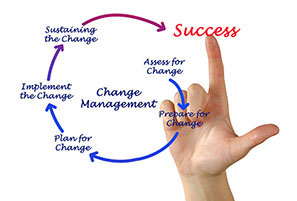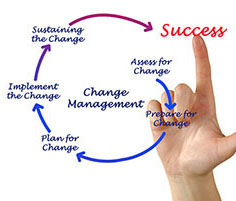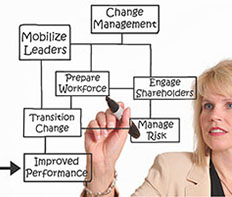Managing Change
For many organisations the field of change management is only just emerging, some organisations cannot see past the large expense that managing change adds to a project whilst others appreciate that it as an important component of successful project delivery.
Definition
Change management applies a structured approach to effectively transition individuals, teams and organizations from the current to the desired future state. Through this structured approach the change leader ensures that the change is smoothly and successfully implemented and embedded, ultimately ensuring the project realizes the benefits outlined in the business case.
More than anything else managing change is the art of people, a great change manager will be incredibly people savvy with strong influencing skills, expert communication and stakeholder management skills and able to align organizational resources in a common direction.
Note: Change managers engage others in the organisation to ensure the successful delivery of change, without the visible support of the project sponsor a change manager cannot guarantee the successful delivery of change into the organisation.
What is Change Management?
Managing change is all about helping people to transition from the old way to the new way. From identifing the change impacts and engage stakeholders in developing plans to ensure all people have the knowledge, skills and confidence to work the new way.
A change manager will follow a structured approach to effectively transition individuals, teams and organizations to the desired future state. Through this structured approach the change leader ensures that the change is smoothly and successfully implemented and embedded, ultimately ensuring the project realizes the benefits outlined in the business case.
The responsibility for managing change has historically rested with the operational managers of the impacted teams or the project managers in the change programs supported by business analysts.
Whilst I will argue that managing change is a primary function of every operational leader and every project manager, you will find that in reality these people are often recruited for their technical skills not their change leadership capabilities, leaving a change capability gap.
This change capability gap has historically resulted in considerable underperformance from change programs, where as many as 80% of organizations reported their programs were not realizing the expected benefits.
This high level of program underperformance has lead researchers to investigate the causes for the failure and the reasons why some programs were successful. These researchers identified that the quality of change capability varied between the performing and non-performing projects.
From this research came the early organizational change theories that emphasized the “people side” of change, this represented the birth of change processes.
When these change processes are followed impacted people will feel engaged in the change and will work collectively towards a common objective, which leads to the project realizing its benefits, and delivering expected results.
As projects become more complex and their impacts widen you will find that the existing project resources will not have the depth of change knowledge required to effectively deliver the change into the business, this results in dedicated and skilled change professionals being employed to plan, execute and manage the change.
These change managers will work with the project manager, business analysts (BA's) and business stakeholders to navigate the change through the organization.
The field of managing organizational change tends to encompass
- Planning for change
- Stakeholder engagement
- Communication
- Skill development (Training or coaching)
- Preparing the organization for change
- Embedding the change
- Measuring the sustainability of the change
You will find that organizational change will directly or indirectly impact one or more of the following aspects of your business
- Your customers
- Number of staff
- Staff location
- Required skills
- Internal working relationships
- Organizational structure
- People or organizational culture
- Existing business processes, or introduces new business processes
- IT Systems
- The working environment
- Work agreements (start time, operating hours)
Note: Change roles includes those ranging from change associate through change manager, senior change manager to change director. It is important to understand that all of these roles manage the change process and make life easy for the leaders of the impacted teams, however only the leader of the impacted teams can actually manage the change.
Why Embrace Organisational Change Management?
Change gurus will often quoted that businesses that embrace organisational change processes have a higher rate of project success than businesses that do not embrace it. On this page we will explore the real reasons for this improvement in project performance.
A quick online search will discover that some consultants are quoting the benefits of embracing managing change citing seemly impossible improvements in project performance, the more extreme benefits are quoted are that 70-80% of projects in organization that have not embraced managing change will fail and 96% of projects in companies that have embraced it will succeed.
Let’s find out what makes up these numbers
To understand how a consultant can be quoting such big improvements in project performance we need to understand how project failure is defined. A project is deemed to have failed if it
- Exceeds budgeted costs
- Takes longer than planned
- Does not deliver the full scope
- Does not realize the benefits quoted in the business case
- Is perceived to be a failure (even if it delivered in full)
Using the above definition of failure you can see why so many projects can fall in the category of “a failed project”
By looking closer at the main reasons why a project fails we will be able to assess the role of change in improving project success. The top most common reasons projects fail are
- The scope was poorly defined, or poorly selected (i.e. the wrong scope was selected)
- Poor project governance including poor project management
- The business environment changes rendering the project partially obsolete
- The project team delivers the project rather than the benefits of the project
- Poor project implementation
(Blue change management will reduce the risk of project failure; black change management will not help reduce the risk of project failure)
From the list above you can see that Change Management will not fix poor project governance, poor project management or poor scope selection.
So then, why are some consultants quoting a 96% project success rate for companies that embrace change management?
The reason is that the companies that have embraced change management have also embraced strong program and project government. These companies have put in place processes to manage each of the risks of project failure and are therefore have greater project success.
Change as a Process
Once an organisation has good project governance in place that includes good project methodology then, it is ready to embrace change. Like project management change can also be described in terms of a process. This change process starts early in the project lifecycle where the change approach/strategy is developed and continues throughout the project concluding at the end of the project by measuring the embedding/sustainability of the change.
Resistance to Change
Within the change body of knowledge there is also a lot of information about resistance to change. The information on resistance includes the common causes of resistance to change and the psychological and organizational drivers of resistance. A voice from Experience: From my personal experience I can tell you that most change managers perceive more resistance to change than is actually present. Resistance to change is often overstated by change agents who
- experience peoples initial reaction to the change but do not wait for the initial emotion to subside to seek the persons response to the change
- are on the lookout for resistance and assign the resistance label too quickly without investigating further
The Change Role
The breath of the job “change manager” is quite diverse. Some change managers working on training and communications whilst others develop complex change strategies and are required to manage difficult stakeholder relationships.
The broader role of a change manager commences at project start up and remains engaged through to benefits realisation.
For example: mapped to Prince2
- Project Start Up: Define the change approach/strategy
- Project initiation: Identify key stakeholders, develop engagement plan and refine the change approach
- Controlling: Communicate with stakeholders, identify change impacts and develop communication plan and training plan
- Project Delivery: Complete business readiness assessments, plan embedding and sustainability metrics and deliver knowledge transfer (Training and communications)
- Project Close: Complete post implementation review
Through the project life the change manager will also contribute to risk and issue management.








